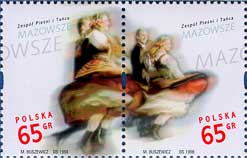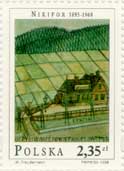MNISZCHÓW PALACE IN WARSAW |
||||
|
||||
| The classicist Miniszchów Palace represented
in the joint Polish-Belgian stamp is located in the centre of Warsaw, at
Senatorska street. The building was erected in 1714 for Great Crown Marshall
Józef W. Mniszch. It was destroyed by the Germans during the Second World
War and reconstructed in 1960 with the financial assistance from the part
of the Kingdom of Belgium.
Over the several centuries, the palace changed not only its owners, but also its utilisation. It belonged, for example to Towarzystwo Resursy Kupieckiej, and even the Masonry, this is why it was used to be called "the Palace of Lucifer" by Warsaw inhabitants. There was housed the Maltan Hospital during the Second World War. The patients and the personnel were murdered by the Germans during the Warsaw Uprising. The Embassy of the Kingdom of Belgium is located today in the Mniszchów Palace. The presented stamp was made according to a design of the Polish artist A. Heidrich, while the engravings was made by an artist from Belgium, G. Broux. The stamp is not only an effect of the co-operation of the post of Poland and Belgium, but also a proof of a liking among the two nations. On the day of introducing the stamp there will be available an envelope of the first day circulation with a special date seal for sale in the Post Office Warsaw 1. |
||||










